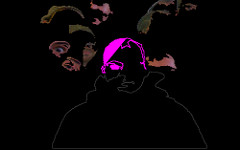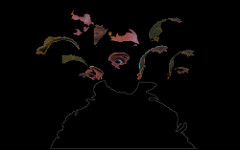- Installation: C’est toi la patate !?
- Authors: Fabien Artal, J.C. Loewe, Raphaël de Staël, Amaury Tatibouët, Roman Viguier
- Direction: Douglas Edric Stanley & Stéphane Cousot
- Workshop: PlayVision
- Exhibition: Gamerz 0.2
- Production: Atelier Hypermédia, Aix-en-Provence School of Art, Transatlab
Here are some screenshots from « C’est toi la patate !? », the design-it-and-build-it-as-fast-as-you-can « installation ludique » we created in just under 4 days during the PlayVision workshop. The main goal of this installation was to use our still-in-construction Open Computer Vision library for Processing in a real-world context and see if it could hold up. Conclusion? So far, so good.
The idea is very simple. You stand in front of a screen which acts as a surveillance-system/mirror. If you hold a part of your body still, the computer will take a picture of it and detach it from the rest of your body. Once you have detached the body part, you can play with it by moving your body around. The installation stores many body parts, leaving a sort of weak memory trail which (re)connects the successive players to one other over time.
We called it an « installation ludique » in response to an idea put forth by Jean-Baptiste Labrune during the opening Transatlab brainstorming session. I had been talking about Huizinga’s and Caillois’ theories around games and play, and Jean-Baptiste suggested we also keep in mind Winnicott’s theories around free play. The idea of a game open enough for the rules to more or less emerge during gameplay appealed to us greatly. This is one of the reasons there is no real specific goal to our « game », outside of the fairly obvious constraints of the interactive algorithm itself and the behavior required to achieve whatever it is you want to do. Jean-Baptiste also insisted that this model of gameplay has a power relation: it could be suggested that those who generate the rules, are exceptions to them.
Unsurprisingly, most people have been playing with the mirror from a purely narcissistic desire: fascinated by the pure game of self-recognition. Mirrors, apparently, still fascinate us. However, very quickly (in fact, almost immediately), people figured out that you could tell stories with it, and even salacious ones at that. By detaching your fingers in a suggestive manner and pushing them into suggestive configurations of body parts, one can in fact construct a compelling little marionette play, albeit a somewhat simplistic one. Funny that those two configurations — reflection and storytelling — should both be so immediately compatible in an interactive context, so easy to tap into. There is a great word for this which I used back in my pre-doctoral thesis on interactivity, namely « relation ». Relation, in French, can mean both a relation (in the English sense of relationship) and the act storytelling, i.e. the process of relating something to someone else. Interactivity, I wrote back then, was often about relation: what story is constructed in the liminary space generated between the player and the machine?




Original Comments:
Peter Kirn
That’s looking really beautiful. Hope to see more! And nice to see the library being used so artfully.